|
Wuzuquan/ Shaolin Five Ancestor Gong Fu
WHO WERE ‘THE FIVE ANCESTORS'?
THE FIVE ANCESTORS were not individuals as such, but rather exemplary master-exponents of specific Gong Fu self-defence/fighting systems (and even then modified in their final stage of finished perfection by a sixth influence – ‘The Lady in The Green Dress [Hian Loo]). Wuzuquan is an art, having an infusion of five great systems. To learn more about the history of Wuzuquan please visit our Articles Page.
The FIVE ANCESTORS were the exponents of the following: Damo: Luohan Quan: Taizu: Baihe Quan: Xing Zhe Quan
Added to these were modifications by Hian Loo (The ‘Lady in the Green Dress’).
Damo (Tat Choon)
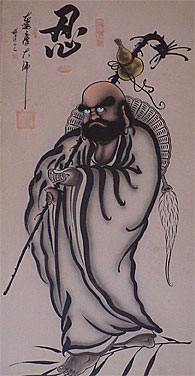 Damo introduced Qi-Gong exercises to the Chinese monks and it is from Damo that the breathing techniques of Wuzu are derived. An Indian monk who travelled from India to Guangzhou (Canton) in 520, and thence by foot to Song Mountain Henan, where he settled in the Shaolin Temple (then hardly a century old): Damo (Bodhidarma) was the 28th Patriarch of Buddhism and the First Patriarch of Chan (Zen) Buddhism. Damo introduced Qi-Gong exercises to the Chinese monks and it is from Damo that the breathing techniques of Wuzu are derived. An Indian monk who travelled from India to Guangzhou (Canton) in 520, and thence by foot to Song Mountain Henan, where he settled in the Shaolin Temple (then hardly a century old): Damo (Bodhidarma) was the 28th Patriarch of Buddhism and the First Patriarch of Chan (Zen) Buddhism.
At the Temple he found the monks in poor health, hardly able to carry out their important spiritual duties. At the end of his famous nine year long meditation (carried out in a cave to the rear of the Temple) he realised that his long period of sitting had atrophied his leg muscles to the point of immobility. He sought a remedy to this problem (and fortuitously to that of the health condition of his fellow monks as well) through specially devised breath control exercises, combined with meditation (mind-intent).
Through these excercises his mobility was progressively regained and his vitality greatly increased, for he had generated and directed his qi through the qi-gong exercises he had discovered. These, he taught the monks, who were not only swiftly restored to good health and gained great powers of concentration, but also found aspects of the system could be used in self-defence.
Damo is reputedly the creator of the 18 Lohan Hand Forms. He pursued his travels once again having taught the monks Ch’an Buddhism. He inspired the writing of two famous books, The ‘I Chin Ching/ I Jin Jing’ (The Sinew Change Classic), and the ‘Sui King Chin/Sui King Jin’ (Washing Marrow Classic): both teach the meditation and respiratory techniques for developing the Qi and hand movements.
Luohan Quan (Lohan): (The Immortal)
The original Shaolin system. Luohan Quan was created by the expert monks of the Shaolin temple in honour of the 18 Luohans, or immortals.
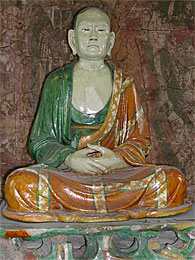 The characteristics of the system are correct posture, dynamic strength and internal power. The18 Buddhist Immortals, legendary figures whose affinity with mankind is renowned, gave their name to this distinctive ancient Shaolin boxing system. The characteristics of the system are correct posture, dynamic strength and internal power. The18 Buddhist Immortals, legendary figures whose affinity with mankind is renowned, gave their name to this distinctive ancient Shaolin boxing system.
They encapsulate the generation of dynamic power through expansion and contraction of the muscles of the body and its limbs in unison with breath control techniques: the system is therefore not surprisingly renowned for its body posture and fist techniques. Each Luohan has a special name and distinctive characteristic appropriate to martial skills and powers: in the images and statues depicting the Lohan, each has either a symbolic object or a wild animal in close proximity.
Taizu (Tai Chor): (Zhao Kuang Yin)
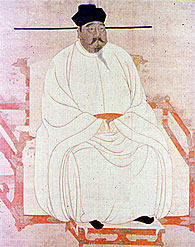 Zhao Kuang Yin, was the first Emperor of the Sung Dynasty, also known as the Sung Grand Ancestor, or Emperor Taizu, he was famous for his martial arts skills and established his own system, the majestic and graceful characteristics of which are proportion in one's movements, accuracy and a minimum of effort. Zhao Kuang Yin, was the first Emperor of the Sung Dynasty, also known as the Sung Grand Ancestor, or Emperor Taizu, he was famous for his martial arts skills and established his own system, the majestic and graceful characteristics of which are proportion in one's movements, accuracy and a minimum of effort.
The Emperor (reigned 960 – 976) was not only a great military leader and strategist, and a cultured caring Father of his Nation, but also an innovative pugilist. He was not the inventor of the first system of Emperor Fist Boxing (of which there are more than one variety), but gave his name to the greatest of these systems, so that Emperor Fist and his name have ever since been synonymous.
The System is also known as Square Boxing, characterised by distinctive and emphatic linear movements which are visually deeply impressive. The System’s Hand Techniques are no less distinctive, being forcefully applied by simultaneously stamping and exhalation of the Dantien. Zhao Kuang Yin also invented a martial Form, using the Three Section Cudgel.
Baihe Quan/ White Crane (Pei Hoke): Yinyang Baihe
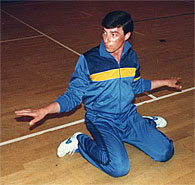 White Crane comprises usage of the open palm; there are 8 forceful and dynamic hand techniques, complimented by 24 refined and delicate hand movements. White Crane comprises usage of the open palm; there are 8 forceful and dynamic hand techniques, complimented by 24 refined and delicate hand movements.
The system was created by an unknown martial arts exponent who while walking along a riverbank was disturbed by the commotion of two cranes locked in battle. He observed the way they used their wings and beaks for defence and attack, and from these observations, modified and adapted the crane techniques into a fighting system.
Shaolin Wuzuquan uses the Yinyang Baihequan School of White Crane techniques (one of four known in traditional Chinese martial arts). The unpredictability of the flapping of the Cranes’ wings is highly dangerous transformed into fighting application.
Monkey Style (Soo Heng Cheh)
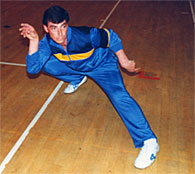 Monkey Style, characteristics of which are its nimble and cunning footwork, agility, and evasive skills. Monkey Style, characteristics of which are its nimble and cunning footwork, agility, and evasive skills.
The origins of Monkey Style Boxing are ancient: the first recorded allusion to it occurred as long ago as the Han Dynasty (206 BCE- 220 CE) where it was reputedly performed at the Imperial Court as part of the ‘Mi Hou Wu Dance.‘
Although small and apparently weak, the monkey is tenacious, extremely agile, fleet of foot, and hard to catch. In particular apart from its aptitude for grabbing, light jumping, controlled falling, and lunging, it is possessed of the ability to turn its hand and arm - once locked at the wrist - into a single, long, and very powerful hand, which it uses for defence or attack.
Practitioners of Monkey Style apply the exceptional evasive tactics and fighting skills of the monkey to their own defensive and fighting techniques in a way which is extremely difficult to counter.
Hian Loo (The Lady in the Green Dress)
Hian Loo, ‘The Lady in the Green Dress,’ completed the refinement of the Wuzuquan System with the most deadly of its techniques – DIM MAK – lethal strikes to the pressure points of the body.
No less importantly she taught her fellow founders of the system the wisdom of being Humble in attitude, and discrete as regards demonstrating and speaking about the art they had created: a classic value of all true and high level Gong Fu martial artists.
LEGENDARY AND FACTUAL GONG FU HISTORY
NOTE CONCERNING THE OBJECTIVITY AND RESEARCH OF MODERN HISTORIANS CONTRADICTING ACCEPTED/ LEGENDARY HISTORY OF CHINESE MARTIAL ARTS:
For some modern/twentieth century historians of Chinese martial arts, Damo is a controversial figure. Such scholars as Tang Hao, who deeply and dispassionately researched the historical records available, have concluded that there is no evidence to suggest that Damo did – or could have ever – taught the monks of the Shaolin Temple any martial arts.
The truth of the matter can never be known, but at the very least it is certain that the health giving and sustaining Qi-Gong techniques attributed to him, are more than credible from the little we know of his life while at the famous temple. As to the reputed martial arts teaching dimension attributed to him, at the very least it is not far-fetched to assert that one or two of the most suitably gifted monks who knew him personally, to whom he taught his Qi-Gong and therapeutic breathing techniques may have put the benefits these bestowed to martial use.
Whichever explanation be the true one, it is certain that Damo directly or indirectly has a unique place of honour in the System of martial arts to which his name is given, and which provides a most indispensable part of Wuzuquan.
|
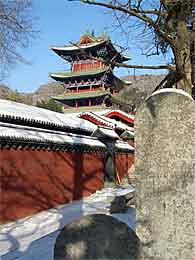
 Damo introduced Qi-Gong exercises to the Chinese monks and it is from Damo that the breathing techniques of Wuzu are derived. An Indian monk who travelled from India to Guangzhou (Canton) in 520, and thence by foot to Song Mountain Henan, where he settled in the Shaolin Temple (then hardly a century old): Damo (Bodhidarma) was the 28th Patriarch of Buddhism and the First Patriarch of Chan (Zen) Buddhism.
Damo introduced Qi-Gong exercises to the Chinese monks and it is from Damo that the breathing techniques of Wuzu are derived. An Indian monk who travelled from India to Guangzhou (Canton) in 520, and thence by foot to Song Mountain Henan, where he settled in the Shaolin Temple (then hardly a century old): Damo (Bodhidarma) was the 28th Patriarch of Buddhism and the First Patriarch of Chan (Zen) Buddhism. Zhao Kuang Yin, was the first Emperor of the Sung Dynasty, also known as the Sung Grand Ancestor, or Emperor Taizu, he was famous for his martial arts skills and established his own system, the majestic and graceful characteristics of which are proportion in one's movements, accuracy and a minimum of effort.
Zhao Kuang Yin, was the first Emperor of the Sung Dynasty, also known as the Sung Grand Ancestor, or Emperor Taizu, he was famous for his martial arts skills and established his own system, the majestic and graceful characteristics of which are proportion in one's movements, accuracy and a minimum of effort. White Crane comprises usage of the open palm; there are 8 forceful and dynamic hand techniques, complimented by 24 refined and delicate hand movements.
White Crane comprises usage of the open palm; there are 8 forceful and dynamic hand techniques, complimented by 24 refined and delicate hand movements.  Monkey Style, characteristics of which are its nimble and cunning footwork, agility, and evasive skills.
Monkey Style, characteristics of which are its nimble and cunning footwork, agility, and evasive skills.